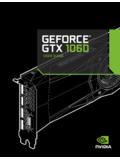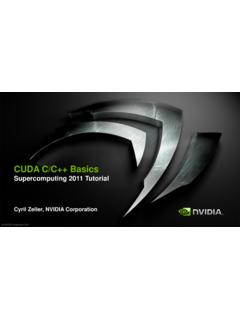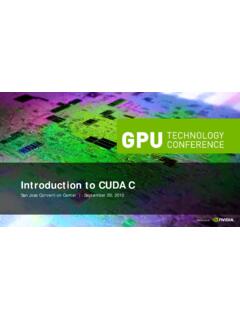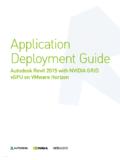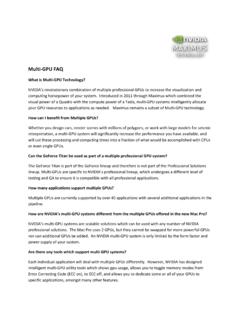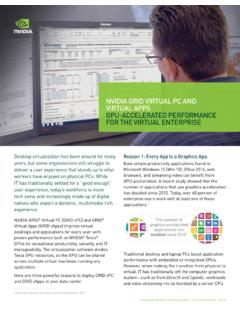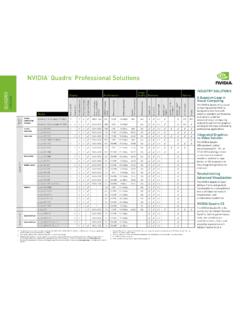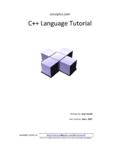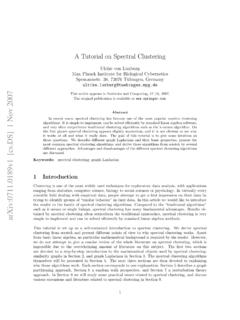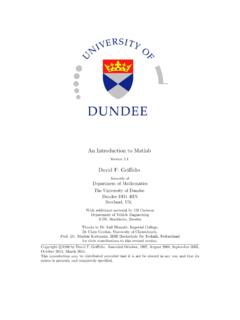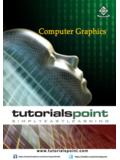Transcription of CUDA C/C++ Basics - nvidia.com
1 CUDA C/C++ Basics Supercomputing 2011 Tutorial Cyril Zeller, nvidia Corporation nvidia Corporation 2011. What is CUDA? CUDA Architecture Expose GPU computing for general purpose Retain performance CUDA C/C++. Based on industry-standard C/C++. Small set of extensions to enable heterogeneous programming Straightforward APIs to manage devices, memory etc. This session introduces CUDA C/C++. nvidia Corporation 2011. Introduction to CUDA C/C++. What will you learn in this session? Start from Hello World! . Write and execute C code on the GPU. Manage GPU memory Manage communication and synchronization nvidia Corporation 2011. Prerequisites You (probably) need experience with C or C++. You don't need GPU experience You don't need parallel programming experience You don't need graphics experience nvidia Corporation 2011.
2 Heterogeneous Computing Blocks Threads Indexing CONCEPTS Shared memory __syncthreads(). Asynchronous operation Handling errors Managing devices nvidia Corporation 2011. CONCEPTS Heterogeneous Computing Blocks Threads Indexing Shared memory __syncthreads(). Asynchronous operation Handling errors HELLO WORLD! Managing devices nvidia Corporation 2011. Heterogeneous Computing Terminology: Host The CPU and its memory (host memory). Device The GPU and its memory (device memory). Host Device nvidia Corporation 2011. Heterogeneous Computing #include <iostream>. #include <algorithm>. using namespace std;. #define N 1024. #define RADIUS 3. #define BLOCK_SIZE 16. __global__ void stencil_1d(int *in, int *out) {. __shared__ int temp[BLOCK_SIZE + 2 * RADIUS].}
3 Int gindex = + * ;. int lindex = + RADIUS;. // Read input elements into shared memory temp[lindex] = in[gindex];. if ( < RADIUS) {. temp[lindex - RADIUS] = in[gindex - RADIUS];. temp[lindex + BLOCK_SIZE] = in[gindex + BLOCK_SIZE];. device code parallel function }. // Synchronize (ensure all the data is available). __syncthreads();. // Apply the stencil int result = 0;. for (int offset = -RADIUS ; offset <= RADIUS ; offset++). result += temp[lindex + offset];. // Store the result out[gindex] = result;. }. serial function void fill_ints(int *x, int n) {. fill_n(x, n, 1);. }. int main(void) {. int *in, *out; // host copies of a, b, c int *d_in, *d_out; // device copies of a, b, c int size = (N + 2*RADIUS) * sizeof(int).
4 // Alloc space for host copies and setup values serial code in = (int *)malloc(size); fill_ints(in, N + 2*RADIUS);. out = (int *)malloc(size); fill_ints(out, N + 2*RADIUS);. // Alloc space for device copies cudaMalloc((void **)&d_in, size);. host code cudaMalloc((void **)&d_out, size);. // Copy to device cudaMemcpy(d_in, in, size, cudaMemcpyHostToDevice);. cudaMemcpy(d_out, out, size, cudaMemcpyHostToDevice);. // Launch stencil_1d() kernel on GPU. stencil_1d<<<N/BLOCK_SIZE,BLOCK_SIZE>>>(d_in + RADIUS, d_out + RADIUS);. // Copy result back to host parallel code cudaMemcpy(out, d_out, size, cudaMemcpyDeviceToHost);. // Cleanup free(in); free(out);. cudaFree(d_in); cudaFree(d_out);. return 0;. serial code }. nvidia Corporation 2011.
5 Simple Processing Flow PCI Bus 1. Copy input data from CPU memory to GPU. memory nvidia Corporation 2011. Simple Processing Flow PCI Bus 1. Copy input data from CPU memory to GPU. memory 2. Load GPU code and execute it, caching data on chip for performance nvidia Corporation 2011. Simple Processing Flow PCI Bus 1. Copy input data from CPU memory to GPU. memory 2. Load GPU program and execute, caching data on chip for performance 3. Copy results from GPU memory to CPU. memory nvidia Corporation 2011. Hello World! int main(void) {. printf("Hello World!\n");. return 0;. }. Output: Standard C that runs on the host $ nvcc $ nvidia compiler (nvcc) can be used to compile Hello World! programs with no device code $. nvidia Corporation 2011.
6 Hello World! with Device Code __global__ void mykernel(void) {. }. int main(void) {. mykernel<<<1,1>>>();. printf("Hello World!\n");. return 0;. }. Two new syntactic elements . nvidia Corporation 2011. Hello World! with Device Code __global__ void mykernel(void) {. }. CUDA C/C++ keyword __global__ indicates a function that: Runs on the device Is called from host code nvcc separates source code into host and device components Device functions ( mykernel()) processed by nvidia compiler Host functions ( main()) processed by standard host compiler - gcc, nvidia Corporation 2011. Hello World! with Device Code mykernel<<<1,1>>>();. Triple angle brackets mark a call from host code to device code Also called a kernel launch.
7 We'll return to the parameters (1,1) in a moment That's all that is required to execute a function on the GPU! nvidia Corporation 2011. Hello World! with Device Code __global__ void mykernel(void) {. }. int main(void) { Output: mykernel<<<1,1>>>();. $ nvcc printf("Hello World!\n");. $ return 0;. Hello World! }. $. mykernel() does nothing, somewhat anticlimactic! nvidia Corporation 2011. Parallel Programming in CUDA C/C++. But wait GPU computing is about massive parallelism! We need a more interesting example . We'll start by adding two integers and build up to vector addition a b c nvidia Corporation 2011. Addition on the Device A simple kernel to add two integers __global__ void add(int *a, int *b, int *c) {. *c = *a + *b.}
8 }. As before __global__ is a CUDA C/C++ keyword meaning add() will execute on the device add() will be called from the host nvidia Corporation 2011. Addition on the Device Note that we use pointers for the variables __global__ void add(int *a, int *b, int *c) {. *c = *a + *b;. }. add() runs on the device, so a, b and c must point to device memory We need to allocate memory on the GPU. nvidia Corporation 2011. Memory Management Host and device memory are separate entities Device pointers point to GPU memory May be passed to/from host code May not be dereferenced in host code Host pointers point to CPU memory May be passed to/from device code May not be dereferenced in device code Simple CUDA API for handling device memory cudaMalloc(), cudaFree(), cudaMemcpy().
9 Similar to the C equivalents malloc(), free(), memcpy(). nvidia Corporation 2011. Addition on the Device: add(). Returning to our add() kernel __global__ void add(int *a, int *b, int *c) {. *c = *a + *b;. }. Let's take a look at main() . nvidia Corporation 2011. Addition on the Device: main(). int main(void) {. int a, b, c; // host copies of a, b, c int *d_a, *d_b, *d_c; // device copies of a, b, c int size = sizeof(int);. // Allocate space for device copies of a, b, c cudaMalloc((void **)&d_a, size);. cudaMalloc((void **)&d_b, size);. cudaMalloc((void **)&d_c, size);. // Setup input values a = 2;. b = 7;. nvidia Corporation 2011. Addition on the Device: main(). // Copy inputs to device cudaMemcpy(d_a, &a, size, cudaMemcpyHostToDevice).}
10 CudaMemcpy(d_b, &b, size, cudaMemcpyHostToDevice);. // Launch add() kernel on GPU. add<<<1,1>>>(d_a, d_b, d_c);. // Copy result back to host cudaMemcpy(&c, d_c, size, cudaMemcpyDeviceToHost);. // Cleanup cudaFree(d_a); cudaFree(d_b); cudaFree(d_c);. return 0;. }. nvidia Corporation 2011. CONCEPTS Heterogeneous Computing Blocks Threads Indexing Shared memory __syncthreads(). Asynchronous operation Handling errors RUNNING IN PARALLEL Managing devices nvidia Corporation 2011. Moving to Parallel GPU computing is about massive parallelism So how do we run code in parallel on the device? add<<< 1, 1 >>>();. add<<< N, 1 >>>();. Instead of executing add() once, execute N times in parallel nvidia Corporation 2011. Vector Addition on the Device With add() running in parallel we can do vector addition Terminology: each parallel invocation of add() is referred to as a block The set of blocks is referred to as a grid Each invocation can refer to its block index using __global__ void add(int *a, int *b, int *c) {.

